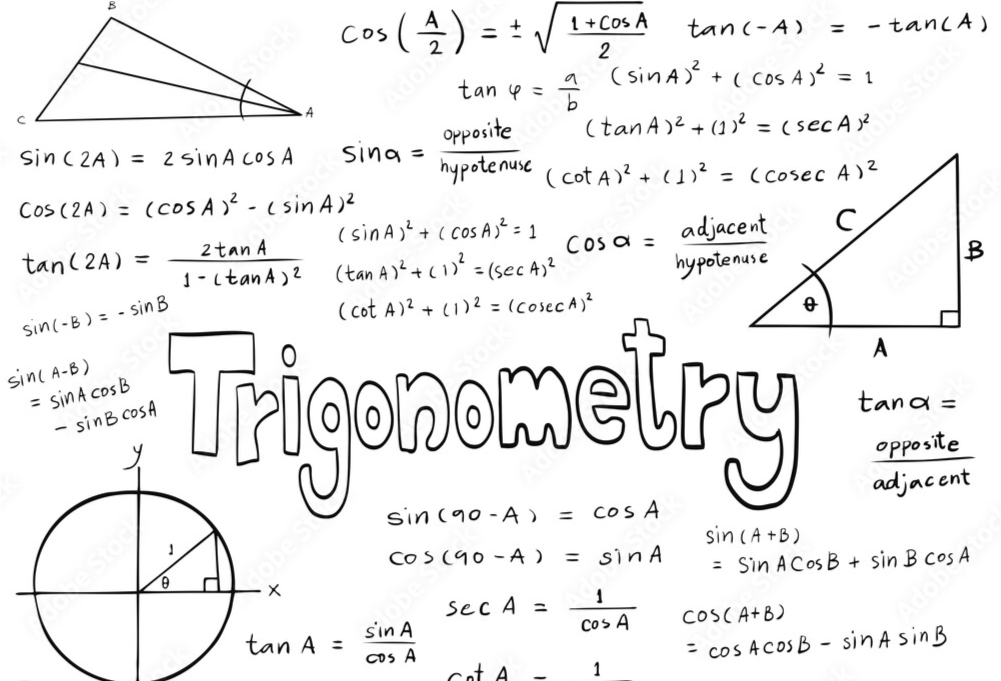Trigonometry, derived from the Greek words "trigonon" ("triangle") and "metron" ("to measure"), focused on computing numerical values of triangle parts or shapes disassembled into triangles. Other parts' values were given until the 16th Century. Pythagoras, Aristotle, or the ancient civilization of the Greeks, Egyptians, and Babylonians may come to mind while looking at the dawn of trigonometry.

Pythagoras, the author of the Pythagorean Theorem, was afraid of beans and had a cult to worship triangles, his followers were not only vegan but also didn't eat beans because they believed that a part of their soul escaped every time, they passed gas.
The Pythagorean Theorem, traditionally known as the square of the hypotenuse's length equalling the sum of squares of the other two sides of a right-angled triangle, formulates as a² + b² = c². For example, (3)² + (4)² = (5)².
The Rhind papyrus (1800 BCE) was an Ancient Egyptian Collection of 84 mathematical problems to the likes as Arithmetic, Algebra, and Geometry. The Geometry portion also consisted of five issues dealing with the seked or what we now refer to as the hypotenuse.
The Rhind papyrus' 56th problem addressed a pyramid with a height of 250 cubits and a length of 360 cubits. The solution provided the ratio of 51/25 palms per cubit, equivalent to the pure ratio 18/25 considering that one cubit equals 7 palms.
This referred to the “run-to-rise” ratio of the pyramid in question—in effect, the cotangent of the angle between the base and face, from this we can examine the Egyptians' extent of knowledge of the numerical relations in a triangle along with trigonometry.
The Greeks initiated modern trigonometry, and Hipparchus (120 BCE) formulated the table of values for trigonometric functions. Being an astronomer, he focused on spherical triangles formed by three stars on the celestial sphere. Still, he was also familiar with the basic formulas of plane trigonometry.
The symbols for trigonometry were formulated only in the 17th Century. Ptolemy’s Almagest was the first major ancient work on trigonometry to reach Europe that uses some elementary trigonometry that led to Ptolemy’s geocentric system being a succession of the heliocentric system of Nicolaus Copernicus.
The Babylonians used the Pythagorean Theorem some 1,000 years before Pythagoras was born. They wrote it down on a tablet now known as Plimpton 322.
The ancient Egyptians, Chinese, and Indians all used versions of its centuries before Pythagoras. An ancient Babylonian tablet used the Pythagorean Theorem 1200 years before Pythagoras was born.
India and the Islamic world were also great contributors to trigonometry which makes you wonder about the true importance and value of Mathematics as recent research shows us that 4000 years ago Neanderthals also had a basic sense of Mathematics.
FAQ: History of Trigonometry
Trigonometry has a rich history that dates back to ancient civilizations. It originated in ancient Greece and India, with early contributions from mathematicians like Hipparchus and Aryabhata. These ancient scholars developed trigonometric concepts to solve problems related to astronomy and geometry.
Three important points about the origin of trigonometry:
1. Ancient Mesopotamia: The earliest known trigonometric concepts can be found in the ancient Mesopotamian civilization, around 2000 BCE. They used basic trigonometry to solve problems related to construction and land measurement.
2. Ancient Egypt: Ancient Egyptians also employed trigonometric principles, particularly in their architectural and engineering projects such as the construction of pyramids. They relied on geometric methods for measuring angles and distances.
3. Ancient Greece: The Greeks, notably mathematicians like Hipparchus and Ptolemy, made significant contributions to trigonometry. They developed more formalized methods and introduced the concept of chords, which laid the foundation for modern trigonometric functions.
Trigonometry underwent significant development in ancient India, where scholars made pioneering contributions to the field.
Three important points about the evolution of trigonometry in ancient India:
1. Aryabhata's Contributions: Aryabhata, an Indian mathematician and astronomer from the 5th century, wrote the "Aryabhatiya," which contained trigonometric tables and formulas. He introduced the concept of sine and explored its properties.
2. Bhaskara I and Brahmagupta: Mathematicians like Bhaskara I and Brahmagupta made further advancements in trigonometry. They extended trigonometric functions to non-right triangles and introduced new concepts like versine and inverse sine.
3. Influence on Islamic Mathematics: India's trigonometric discoveries had a profound impact on Islamic mathematics during the medieval period. Islamic scholars translated and expanded upon Indian trigonometric works, preserving and disseminating this knowledge.
Islamic mathematics played a crucial role in preserving and advancing trigonometry during the Middle Ages.
Three important points about the role of trigonometry in Islamic mathematics:
1. Translation Movement: Islamic scholars translated Greek, Indian, and Babylonian mathematical texts into Arabic. This included works on trigonometry, which were then further developed and refined.
2. Al-Battani and Trigonometric Tables: Al-Battani, also known as Albategnius, made significant contributions to trigonometry in the 9th century. He calculated more accurate values for trigonometric functions and compiled extensive trigonometric tables.
3. Al-Khwarizmi's Influence: Al-Khwarizmi, an influential Islamic mathematician, contributed to the development of trigonometry by refining and standardizing its methods. His work laid the groundwork for the later European development of trigonometry.
Trigonometry was reintroduced to medieval Europe through the translation of Islamic mathematical texts, leading to further developments and applications.
Three important points about the development of trigonometry in medieval Europe:
1. Fibonacci's Liber Abaci: Fibonacci, an Italian mathematician, included trigonometric concepts in his book "Liber Abaci" in the 13th century. This helped reintroduce and popularize trigonometry in Europe.
2. Reintroduction of Greek Ideas: European scholars began to revisit and study ancient Greek trigonometric ideas, including chord functions. This led to the formulation of new trigonometric relationships.
3. Regiomontanus and the Renaissance: Regiomontanus, a German mathematician of the 15th century, played a pivotal role in the development of trigonometry during the Renaissance. He improved trigonometric tables and made trigonometry an integral part of astronomy.
Key figures in the history of trigonometry include Hipparchus, who created the first trigonometric table; Ptolemy, known for his work on chords and circles; and the Indian mathematician Aryabhata, who introduced the concept of sine.
Trigonometry continued to develop throughout history, with contributions from Islamic scholars during the Golden Age of Islam. They expanded on Greek and Indian trigonometry and introduced trigonometric functions as we know them today.
Trigonometry played a crucial role in early astronomy, navigation, and surveying. It was used to calculate distances, angles, and positions of celestial objects and landmarks, contributing to the development of science and exploration.
Trigonometry became a fundamental branch of mathematics during the Renaissance and the Scientific Revolution. Mathematicians like Johannes Kepler and Isaac Newton used trigonometric principles to formulate laws of planetary motion and calculus, respectively.
Historical trigonometric theorems and formulas include the Pythagorean theorem, which relates the sides of a right triangle, and the law of sines and law of cosines, which are used to solve non-right triangles.
Modern trigonometry, as we know it today, has evolved over centuries through the contributions of mathematicians from various cultures.
Three important points about the evolution of modern trigonometry:
1. Redefining Trigonometric Functions: The transition from chords to the familiar sine, cosine, and tangent functions occurred during the Renaissance. This made trigonometry more versatile and applicable to a wider range of problems.
2. 18th-Century Advances: Mathematicians in the 18th century, such as Leonhard Euler and Jean le Rond d'Alembert, made significant contributions to trigonometry. Euler's work on complex numbers and exponential functions greatly influenced modern trigonometry.
3. Integration with Calculus: Trigonometry became closely integrated with calculus in the 19th century, as mathematicians like Augustin-Louis Cauchy and Joseph Fourier used trigonometric functions to study periodic phenomena and solve differential equations.
Trigonometry remains essential in fields such as physics, engineering, computer graphics, and architecture. It is used in designing structures, analysing waveforms, and solving complex mathematical problems.
To learn more about the history of trigonometry, consider reading books like "A History of Mathematics" by Carl B. Boyer and exploring educational websites and academic journals dedicated to mathematics history.
In conclusion, the history of trigonometry is a fascinating journey that spans millennia and encompasses contributions from diverse cultures and scholars. From its humble beginnings in ancient civilizations to its modern applications in mathematics, science, and engineering, trigonometry has evolved into a fundamental and indispensable branch of mathematics.

